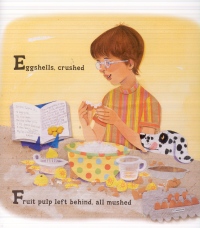| ________________
CM . . . . Volume XVII Number 7. . . .October 15, 2010. 
 |
Compost Stew: An A to Z Recipe for the Earth.
Mary McKenna Siddals. Illustrated by Ashley Wolff.
Berkeley, CA: Tricycle Press (Distributed by Random House), 2010.
32 pp., hardcover, $15.99.
ISBN 978-1-58246-316-2.
Subject Headings:
Stories in rhyme.
Compost-Juvenile fiction.
Preschool-grade 2 / Ages 4-7.
Review by Dave Jenkinson.
***/4
|
| |
|

excerpt:
Environmental chefs
here’s a recipe for you
to fix from scratch
to mix a batch
of Compost Stew
Ingredients:
Apple cores
Bananas bruised
Coffee grounds
with filters used
Using the format of an alphabet book, Mary McKenna Siddals, a former teacher who lives in BC, provides young children with an imaginative and engaging introduction to the concept of composting. Her “poetic” narrators are four children, two boys and two girls, who are accompanied by a goose and a dalmatian dog as they gather the “ingredients” that will go into making their “compost stew.” As shown in the except above, each letter of the alphabet is represented by one compostable item. So that the book doesn’t just become one long list, the author twice uses the cover’s red headed girl to interject the following “chorus”:
Just add to the pot
and let it all rot
into Compost Stew
Perhaps by the time these lines appear for the third time at the book’s conclusion, young listeners may be prepared to join in. Recognizing that there are items that should not be added to a compost pile, Siddals employs a concluding “Chef’s Note” that indicates those items that should be recycled rather than composted. For this section, Siddals continues to use poetry as her narrative vehicle, but prose might have made the no-no’s clearer. An “Author’s Note” on the copyright page includes a URL for a site which leads to a slide show that provides ideas and directions for children on how to compost.
 In the main, the “ingredients” Siddals lists in her “compost stew” recipe will be familiar to the intended young audience though Seaweed strands, obviously, will be geographically limited. Youngsters might be surprised to learn that such things as laundry lint from clothes dryer traps and human hair are compostable. The constraint of having to identify one item for each of the alphabet’s 26 letters can lead to some unusual inclusions, with one being I’s “an Insect or two.” While children can understand how they can obtain grass clippings, nutshells and paper shreds, they will undoubtedly wonder how are they to acquire insects? In the main, the “ingredients” Siddals lists in her “compost stew” recipe will be familiar to the intended young audience though Seaweed strands, obviously, will be geographically limited. Youngsters might be surprised to learn that such things as laundry lint from clothes dryer traps and human hair are compostable. The constraint of having to identify one item for each of the alphabet’s 26 letters can lead to some unusual inclusions, with one being I’s “an Insect or two.” While children can understand how they can obtain grass clippings, nutshells and paper shreds, they will undoubtedly wonder how are they to acquire insects?
Wolff’s lively collage illustrations begin (and conclude) with endpapers that portray what a closeup of composted material might look like. In between, via double-page spreads and single pages, Wolff's bright, colourful collage images show the racially diverse children collecting the various things that they will be adding to their compost stew.
Recommended.
Dave Jenkinson, CM’s editor, lives in Winnipeg, MB.

To comment on this title or this review, send mail to
cm@umanitoba.ca.
Copyright © the Manitoba Library Association. Reproduction for personal use is permitted only if this copyright notice is maintained. Any other reproduction is prohibited without permission.
NEXT REVIEW |
TABLE OF CONTENTS FOR THIS ISSUE- October 15, 2010.
AUTHORS |
TITLES |
MEDIA REVIEWS |
PROFILES |
BACK ISSUES |
SEARCH |
CMARCHIVE |
HOME |

 In the main, the “ingredients” Siddals lists in her “compost stew” recipe will be familiar to the intended young audience though Seaweed strands, obviously, will be geographically limited. Youngsters might be surprised to learn that such things as laundry lint from clothes dryer traps and human hair are compostable. The constraint of having to identify one item for each of the alphabet’s 26 letters can lead to some unusual inclusions, with one being I’s “an Insect or two.” While children can understand how they can obtain grass clippings, nutshells and paper shreds, they will undoubtedly wonder how are they to acquire insects?
In the main, the “ingredients” Siddals lists in her “compost stew” recipe will be familiar to the intended young audience though Seaweed strands, obviously, will be geographically limited. Youngsters might be surprised to learn that such things as laundry lint from clothes dryer traps and human hair are compostable. The constraint of having to identify one item for each of the alphabet’s 26 letters can lead to some unusual inclusions, with one being I’s “an Insect or two.” While children can understand how they can obtain grass clippings, nutshells and paper shreds, they will undoubtedly wonder how are they to acquire insects?